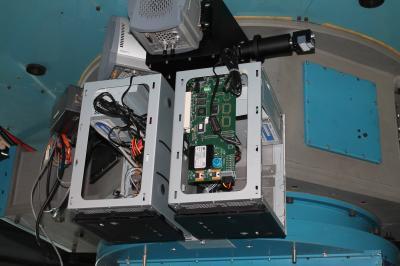Until now, rings of material in a disc have been associated with giant planets like Saturn.
Chariklo, located two billion kilometers away, between Saturn and Uranus, is the first miniature planet with two rings of ice and pebbles. Chariklo was located in the Kuiper Belt, a collection of thousands of dwarf planets and comets in orbit beyond Neptune on the edge of our solar system, but at some point it must have been thrown out of this belt and is now between Saturn and Uranus, where there is a collection of small objects, called Centaur.
Chariklo is the largest of these objects with a diameter of 250 km. This comet like object has been known for many years, but despite careful study, its rings have never been observed before now. This has happened because a new camera is now being used on the Danish telescope at ESO's La Silla Observatory in Chile.
Surprising discovery of rings
When an object passes in front of a star there is a small dip in the star's brightness and they could see that there was also a dip in the brightness outside the object. This showed that there was a ring of material in a disc around the little object, Chariklo.

The special camera takes 40 images per second and is now sitting on the Danish telescope at the La Silla Observatory in Chile. The main purpose of the camera is to observe exoplanets, which are planets orbiting a star other than the Sun, but the sensitive camera has also shown its strength for making extremely precise observations of other objects. Credit: Jesper Skottfelt, Niels Bohr Institute
"We were not even looking for rings, because they had never been observed around small objects like Chariklo, so it is a totally surprising discovery. The entire passage only lasted 5 seconds, but we could even determine incredible details about the rings. There are two separate thin rings, which are comprised of ice particles and pebbles. The two rings are only 3 and 7 km wide and no more than a few hundred meters thick. There are 14 km between the centers of the two rings and there is a 9 km wide gap between them. They have been measured at a distance of two billion kilometers with an accuracy of plus/minus a few hundred meters. It is really impressive," says Uffe Gråe Jørgensen, an astronomer in Astrophysics and Planetary Science at the Niels Bohr Institute at the University of Copenhagen.
Perhaps formed by collision
"The camera was specially developed at the Niels Bohr Institute and has a stunningly high resolution, which we especially exploit to look for exoplanets. But when the area where we are looking for exoplanets isn't 'up' in the sky, we use our observation time for other projects and so we followed Chariklo, which just passed in front of a star," explains Jørgensen.
How the rings were formed is a mystery, but Uffe Gråe has a hypothesis.
"What we are witnessing is perhaps the unveiling of an object that is in the middle of the same stage of development as the Earth and the Moon 4.5 billion years ago, when there was a giant collision between Earth and another planet. In the collision, material hurled out in all directions, forming a circular disc around the Earth, which gradually condensed and formed the Moon. Similarly, we believe that another celestial body crashed into Chariklo and a good deal of material was cast out and formed rings. If the two discs around Chariklo gathers and forms a moon, it will be approximately 2 km in diameter," explains Uffe Gråe.
In addition to the observations with the Danish telescope at La Silla Observatory in Chile, Chariklo was also followed in lower time resolution from six other observatories in South America, which together made it possible to determine Chariklo's shape and size. There were only a few minutes of observations in total, but the result was the breakthrough revelation of the comet like miniature planet Chariklo with the two rings.





Comments